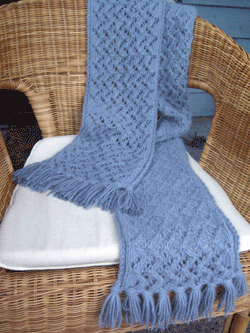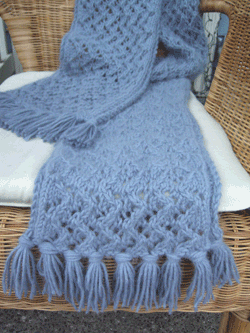I’m teaching a free beginning knitting class tonight to about 10 women at my church. It is 2 hours long. I’m wondering if I should cast on for everybody and just focus on the knit stitch, and possibly the pearl stitch as opposed to jumping right into casting on. My thought is that casting on can seem confusing and overwhelming at first, and by the time we get to actually knitting, they’ll already have the “this isn’t something I can do” attitude. Plus, they won’t remember how to do it when they get home anyway.
Knitting itself is easy, and if I can get them going on that, then if they ever want to cast on for another project, we can address it at that point, and they’ll already be comfortable handling needles.
Or, maybe we can start knitting, and if things are going well enough, we can stop towards the end of class and do the cast on bit.
What do you think?
I haven’t taught a group this big before. I’ve taught plenty of one-on-one’s, and that’s easier because when the “I just can’t do this” crap starts, I can get on their case. In a big group, I don’t think I’ll have that luxury.
Well, by necessity, I’m still photographing on my front porch to get enough light. However this time, to keep things interesting, I brought a prop.
Behold, the zigzag scarf.


After messing around with what felt like a zillion side edgings to open it up, I decided to just pick up stitches and do 2 rows of stockinette with a bigger needle, then bind off on row 3. It made for a tidy little edge that didn’t detract from the lace, and achieved the desired goal of getting the sides to lay flat and not roll. Hehe. Sometimes, simple really is better.
I’ll post the pattern soon.




January 10th, 2006 at 2:49 am
I have not taught a whole class before, but for a single student, I definitely cast on and knit a few rows first! You get them working along immediately and feeling “I CAN do this!” Even for an experienced knitter, the first row is not so easy as what follows. Let us know how it works out!
January 10th, 2006 at 2:52 am
Thanks. That’s my thought exactly.
January 10th, 2006 at 3:07 am
Alternatively, you could teach them a cable cast on, which would give them the feel of the knit stitch, and the casting process at the same time.
January 10th, 2006 at 3:18 am
The scarf is gorgeous! Can’t wait for the pattern. I agree with the first comment – to cast on and give them a few rows so that they know what their product should look like. Once they’re engrossed in how fun actually knitting is, they won’t let the next cast-on deter them!
January 10th, 2006 at 3:19 am
For my learn to knit classes I teach long tail cast on and the knit stitch. For very young children I cast on for them. But I’ve taught students as young as 8 how to cast on and knit in 2 hours.
As far as all the negative talk goes I try to remind people that it’s a learning process. I usually use the analogy of your first time on roller blades. It’s awkward and shaky but you get better with practice.
January 10th, 2006 at 3:22 am
I agree with Suzette, maybe a knit cast on or cable cast on would be best, since they are the same as a knit stitch, pretty much.
January 10th, 2006 at 3:29 am
That scarf is gorgeous!!!!
I just started my kids knitting class at BF last night, and the casting on went well though I only had three students. I could see that in a large group, it might be easier to start with knitting or the cable cast-on method. I’ve just been asked to teach an adult class as well, so that’s exciting!
January 10th, 2006 at 3:35 am
I’ve taught 4 people how to knit so far in about 15 minutes each. Every time, I’ve taught a cable cast on and 2×2 ribbing. I feel that if people learn the knit and purl stitches at the same time they are less likely to find one more difficult than the other. After my 15 minute lessons, my 4 proteges have learned enough to get what they need from books and things, and just kept going.
Of course, all of these were one-on-one situations. Teaching 10 people at the same time would be different. But I’m still for teaching a cast-on. You’ve got 2 hours, but if you’ve only got them casting on 20 or so stitches, there should be time for both casting and knitting.
Have fun!
January 10th, 2006 at 3:57 am
I’ve found that kids learn much better than adults, because they don’t have the mental baggage and pessimism that adults tend to have. When I taught a large group of 10 year olds, I taught them to cast on first, then knit. Adults are different, unfortunately. If the beginning is hard, they frequently write the whole activity off, which is why I’m contemplating this.
I’m enjoying the opinions, thanks!
January 10th, 2006 at 5:44 am
De-lurking to post:
1) that’s a beautiful scarf. Wow.
2) I’ve taught a number of people and believe you me I am not a patient person to begin with, but I’ve always taught them how to cast on before teaching them the knit stitch. It takes a little while for students to catch on, but I’ve only ever had one person not leave the class casting on and knitting away.
I teach beginners the long tail cast on, and my way is a little funky since I use two hands, but since the knit stitch is rather similar, I incorporate the movements from casting on into the knit lesson.
Overall, I just try to stay positive (although once with a group of 10 newbies things got a little hairy. See above re: one person who could not cast on) and the enthusiasm I have for knitting transfers to the people I’m teaching.
Oh boy, this is one wordy post. Anyway, I wish you good luck. Your students will be grateful and appreciative, and you’ll feel like Mighty Mouse when you’re done =)
Kim
January 10th, 2006 at 5:50 am
I want the pattern…it is so pretty.
January 10th, 2006 at 6:26 am
*love* the scarf! And way to beat the roll!
I’m always a fan of teaching cast-on first (the one where you essentially knit a stitch then put it back on the left needle — I don’t know what it’s called), because then they have the skills to start their own project. If you’re doing a series of classes, then maybe it’s not as important. Also I’m a huge advocate of teaching both knit and purl in the first lesson. No need to get new knitters used to only one of the two.
January 10th, 2006 at 8:29 am
I think you should teach them how to cast on…
… love the scarf! can’t wait for the pattern! 🙂
January 10th, 2006 at 8:35 am
I think casting on is really important and I’d start with that.
January 10th, 2006 at 2:21 pm
I can’t really add anything new to the discussion about teaching new knitters except good luck and let us know how it goes!
I adore your new scarf and can feel how soft and yummy it is through the monitor. Enjoy!
January 10th, 2006 at 7:26 pm
I’ll say, if you have a group of 10, perhaps teach them the knitted cast on. Also, have a helper if possible. Makes it way easier!
January 10th, 2006 at 9:36 pm
in my knitting class, I always teach the cast on after they have learned the knit/purl stitch….. and usually first week is learning and practising knit, 2nd week is devoted to purl
January 10th, 2006 at 11:15 pm
Can’t wait for the instructions. That is one yummy scarf. I’d teach the cable case on, so that if they have to rip when they get home and are practicing they can start again and don’t get stuck in the “I can’t phase” until you meet them again. Daryl
January 10th, 2006 at 11:52 pm
Yup, cast on and knit a row to set them all up to start. It it more work for you but totally worth it as far as frustration level goes. What DID you end up doing? Pretty scarf, by the way.
January 12th, 2006 at 4:45 pm
That is a beautiful scarf, but what AWES me is that YOU PICKED UP STITCHES ALL THE WAY UP AND DOWN THE SIDES OF IT!?!?
January 12th, 2006 at 4:46 pm
And you’re WORRIED about teaching 10 ladies to cast on and knit!?
Have you lost your mind!?
Good job!
(I don’t know why my computer split my reply, but the timing was good…)